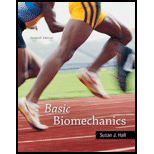
Concept explainers
A runner completes 6½ laps around a 400 m track during a 12 min (720 s) run test. Calculate the following quantities:
a. The distance the runner covered
b. The runner’s displacement at the end of 12 min
c. The runner’s average speed
d. The runner’s average velocity
e. The runner’s average pace (Answers: a. 2.6 km; b. 160 m; c. 3.6 m/s; d. 0.22 m/s; e. 4.6 min/km)
a)
To determine: The distance runner covered.
Answer to Problem 1IP
The distance covered by the runner is
Explanation of Solution
Calculation:
Express the distance covered by the runner.
Substitute
Therefore, distance covered by the runner is
Therefore, distance covered by the runner is
b)
To determine: The runner’s displacement at the end of 12 min.
Answer to Problem 1IP
Displacement by the runner at the end of 12 min is
Explanation of Solution
Calculation:
At 12 min runner completes 6.5 laps and the runner will be at the position of 0.5 lap.
Consider each side of the track is 100 m.
Use Pythagoras theorem to express the runner’s displacement at the end of 12 min.
Substitute
Therefore, displacement by the runner at the end of 12 min is
Therefore, displacement by the runner at the end of 12 min is
c)
To determine: The runner’s average speed.
Answer to Problem 1IP
The average speed of the runner is
Explanation of Solution
Calculation:
Express the average speed of the runner.
Substitute 2600 m for total distance and 12 min to find the average speed.
Therefore, average speed of the runner is
Therefore, average speed of the runner is
d)
To determine: The runner’s average velocity.
Answer to Problem 1IP
The average velocity of the runner is
Explanation of Solution
Calculation:
Express the average velocity of the runner.
Substitute 141.4 m for total displacement and 12 min to find the average velocity.
Therefore, average velocity of the runner is
Therefore, average velocity of the runner is
e)
To determine: The runner’s average pace.
Answer to Problem 1IP
The average pace of the runner is
Explanation of Solution
Calculation:
Express the average pace of the runner.
Substitute
Therefore, average pace of the runner is
Therefore, average pace of the runner is
Want to see more full solutions like this?
Chapter 10 Solutions
Basic Biomechanics
- a cat runs across a road that is 9 meters (m) wide. it covered this distance in 3 seconds (s). what is the speed of the car?arrow_forwardCalculate the estimated O2 cost of horizontal treadmill running (ml . kg -1 . min -1 ) for a 70-kg subject at 150,200, and 235 m . min -1 .arrow_forwardCalculate the total amount of work performed in 5 minutes of exercise on the cycle ergometer, given the following:Resistance on the flywheel = 25 NCranking speed = 60 rpmDistance traveled per revolution = 6 metersarrow_forward
- A scientist was investigating if differences in the frictional work performed on a model car can change depending on its mass (in grams) and whether the car moves up or down an inclined plane. They decided to measure the amount of frictional force experienced by the model car and the distance it traveled in meters. The scientists were able to evaluate the frictional work using the following data. Mass (g) Distance (m) Force Work Done by Friction (J) car going up the incline 100 39 0.063 2.457 car going down the incline 70 39 0.2309 ? It is known that the relationship between force and distance determines the work done by friction (W+). W₁ = fd Wf work done by friction f = force d = distance Question: How much work done by friction was exerted on the car as it moved down the inclined plane? You may use a calculator. 1 2.457 9.005 11.46 16.16 PREVIOUS FINISHarrow_forwardIdentify the apparent temperature when the air temperature is -25 • F and the winspeed is 20 mpharrow_forwardUsing the Michaelis-Mentan graph pictured (graphing initial velocity and PNPP concentration), identify Vmax and Km as well as possible. Then, using the Lineweaver-Burk graph (graphing 1/Vo and 1 / PNPP concentration), label the reciprocals of Vmax and Km on the graph and use them to calculate Km and Vmax.arrow_forward
- Sam walks 2km in 30 minutes. How much time will he take to cover 400meters ? Report your answer in m/s.arrow_forwardExplain why distance running performance decreases at altitude.arrow_forwarda toy car rolls 10 meters (m) across the floor. it takes 5 seconds (s) to cross this distance. what is the speed of this car?arrow_forward
- In three scenarios, the person must jump three times as high as he/she can, and it is recorded in cm. Results: Jumping Variations A. Jump immediately from standing position B. Bend the hips and knees for 5 seconds then jump C. Quickly bend the hips and knees then jump Trial 1 Trial 2 Trial 3 Average 21 22 20 21 30 28 27 28.3 36 38 39 37.67 What are the biological and physiologic explanation/s for the results?arrow_forwardA man runs up a flight of 50 steps in 15 seconds. Calculate mass of man if the power output of his leg muscles 500 W and the vertical height of * ?each step is 0.2 m 85 O 65 O None O 75 Oarrow_forwardYou will be given the formula for speed: No need to memorize it!! What is the difference between speed and velocity? What is the difference between instantaneous speed and average speed? e. quickly slowing SPEED & VELOCITY Vavg Ax=xf-Xi At t, - tiarrow_forward

